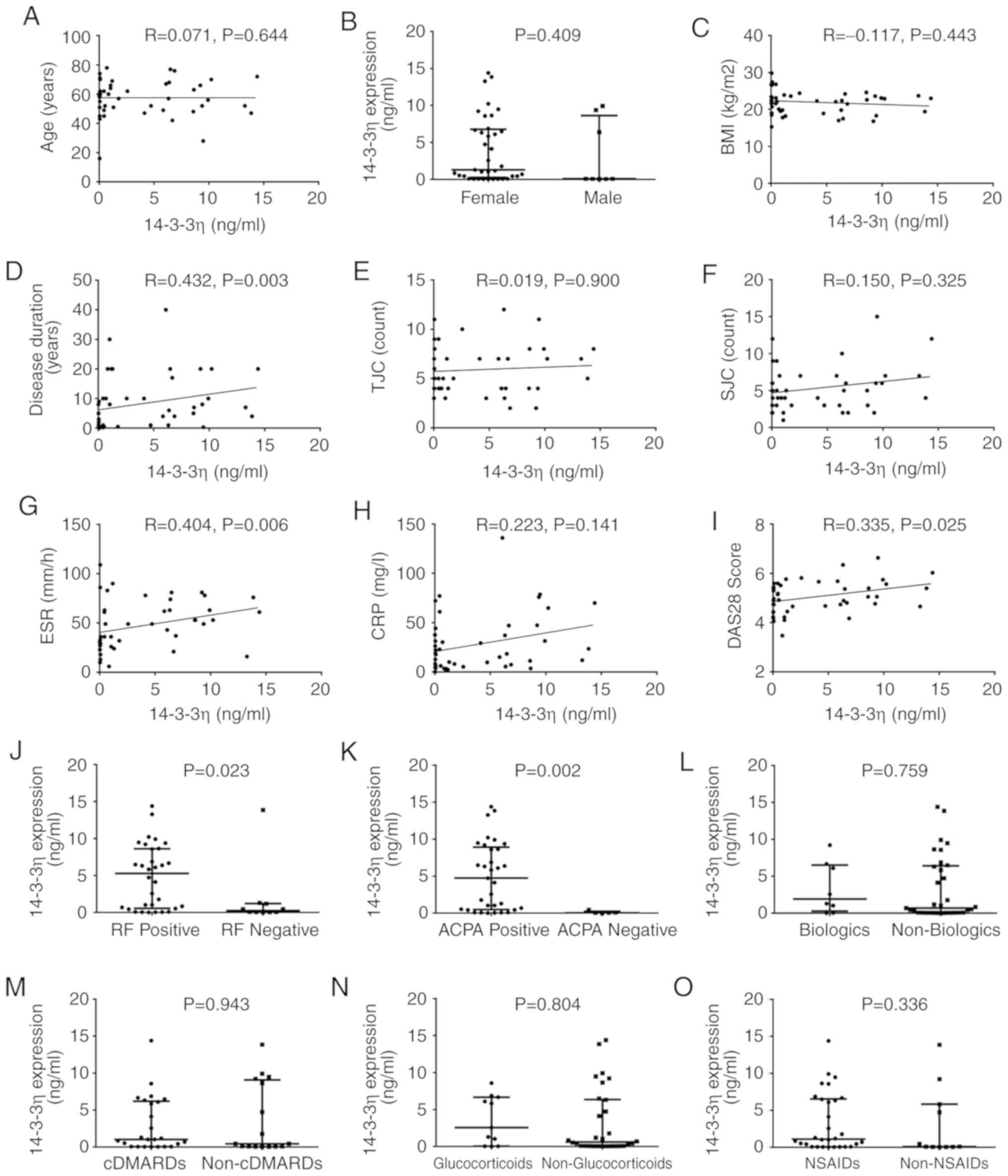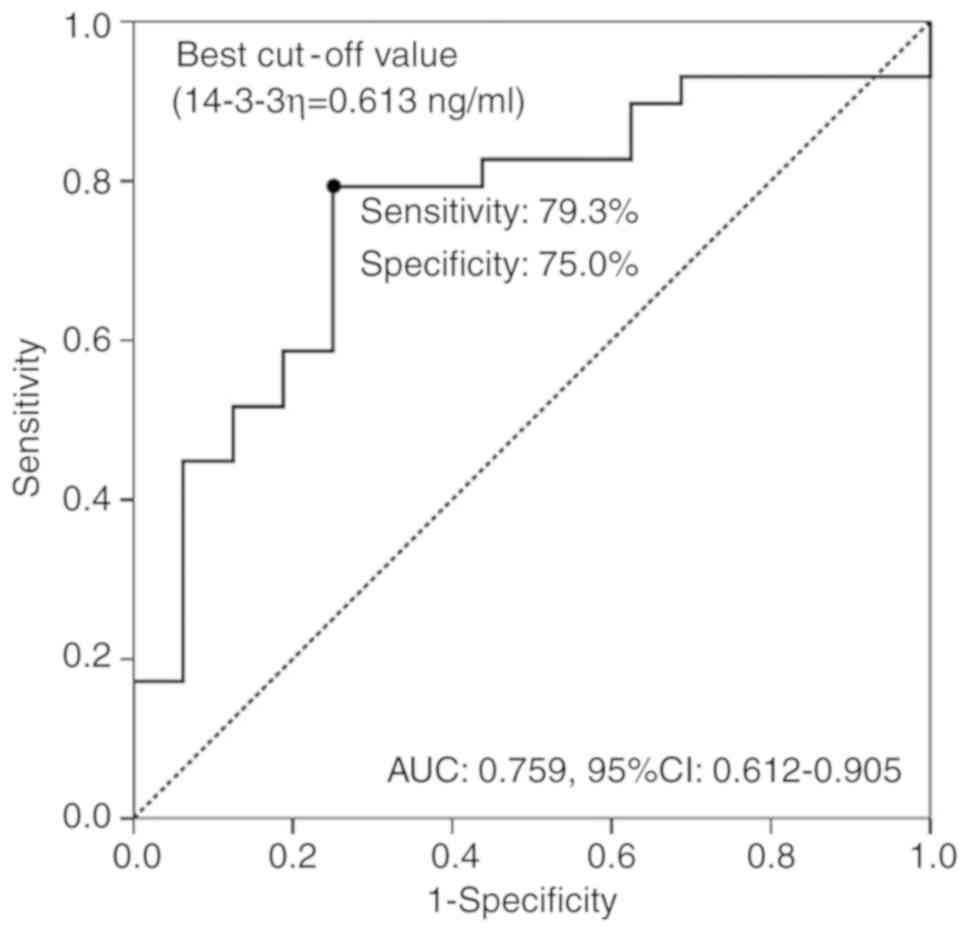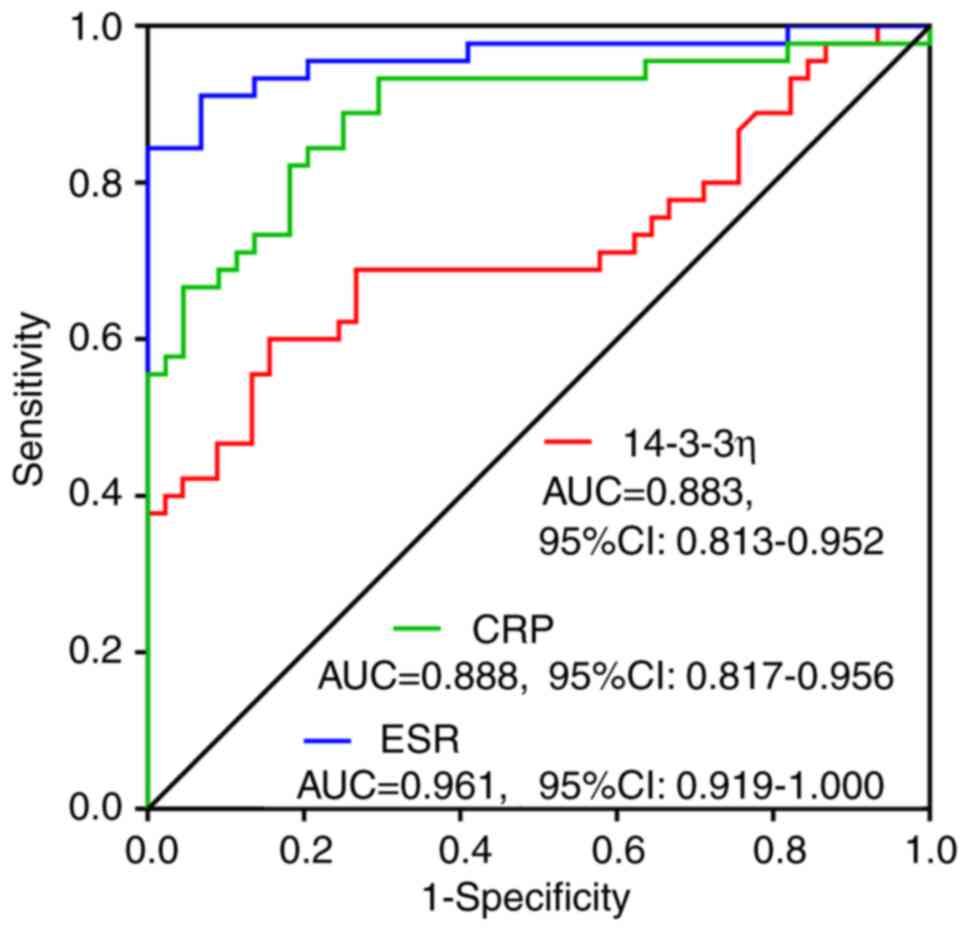|
1
|
Malmstrom V, Catrina AI and Klareskog L:
The immunopathogenesis of seropositive rheumatoid arthritis: From
triggering to targeting. Nat Rev Immunol. 17:60–75. 2017.PubMed/NCBI View Article : Google Scholar
|
|
2
|
Smolen JS, Aletaha D and McInnes IB:
Rheumatoid arthritis. Lancet. 388:2023–2038. 2016.PubMed/NCBI View Article : Google Scholar
|
|
3
|
McInnes IB and Schett G: The pathogenesis
of rheumatoid arthritis. N Engl J Med. 365:2205–2219.
2011.PubMed/NCBI View Article : Google Scholar
|
|
4
|
Scott DL, Wolfe F and Huizinga TW:
Rheumatoid arthritis. Lancet. 376:1094–1108. 2010.PubMed/NCBI View Article : Google Scholar
|
|
5
|
Isaacs JD: The changing face of rheumatoid
arthritis: Sustained remission for all? Nat Rev Immunol.
10:605–611. 2010.PubMed/NCBI View
Article : Google Scholar
|
|
6
|
McInnes IB and Schett G: Pathogenetic
insights from the treatment of rheumatoid arthritis. Lancet.
389:2328–2337. 2017.PubMed/NCBI View Article : Google Scholar
|
|
7
|
Burmester GR and Pope JE: Novel treatment
strategies in rheumatoid arthritis. Lancet. 389:2338–2348.
2017.PubMed/NCBI View Article : Google Scholar
|
|
8
|
Obsil T, Ghirlando R, Klein DC, Ganguly S
and Dyda F: Crystal structure of the 14-3-3zeta:serotonin
N-acetyltransferase complex. A role for scaffolding in enzyme
regulation. Cell. 105:257–267. 2001.PubMed/NCBI View Article : Google Scholar
|
|
9
|
Cau Y, Valensin D, Mori M, Draghi S and
Botta M: Structure, function, involvement in diseases and targeting
of 14-3-3 proteins: An update. Curr Med Chem. 25:5–21.
2018.PubMed/NCBI View Article : Google Scholar
|
|
10
|
Sluchanko NN and Gusev NB: Moonlighting
chaperone-like activity of the universal regulatory 14-3-3
proteins. FEBS J. 284:1279–1295. 2017.PubMed/NCBI View Article : Google Scholar
|
|
11
|
de Boer AH, van Kleeff PJ and Gao J: Plant
14-3-3 proteins as spiders in a web of phosphorylation.
Protoplasma. 250:425–440. 2013.PubMed/NCBI View Article : Google Scholar
|
|
12
|
Jia H, Liang Z, Zhang X, Wang J, Xu W and
Qian H: 14-3-3 proteins: An important regulator of autophagy in
diseases. Am J Transl Res. 9:4738–4746. 2017.PubMed/NCBI
|
|
13
|
Cornell B and Toyo-Oka K: 14-3-3 Proteins
in brain development: neurogenesis, neuronal migration and
neuromorphogenesis. Front Mol Neurosci. 10(318)2017.PubMed/NCBI View Article : Google Scholar
|
|
14
|
Zhao J, Meyerkord CL, Du Y, Khuri FR and
Fu H: 14-3-3 proteins as potential therapeutic targets. Semin Cell
Dev Biol. 22:705–712. 2011.PubMed/NCBI View Article : Google Scholar
|
|
15
|
Kilani RT, Maksymowych WP, Aitken A, Boire
G, St-Pierre Y, Li Y and Ghahary A: Detection of high levels of 2
specific isoforms of 14-3-3 proteins in synovial fluid from
patients with joint inflammation. J Rheumatol. 34:1650–1657.
2007.PubMed/NCBI
|
|
16
|
Maksymowych WP and Marotta A: 14-3-3eta: A
novel biomarker platform for rheumatoid arthritis. Clin Exp
Rheumatol. 32 (Suppl 85)(S35-S39)2014.PubMed/NCBI
|
|
17
|
Hirata S, Marotta A, Gui Y, Hanami K and
Tanaka Y: Serum 14-3-3η level is associated with severity and
clinical outcomes of rheumatoid arthritis, and its pretreatment
level is predictive of DAS28 remission with tocilizumab. Arthritis
Res Ther. 17(280)2015.PubMed/NCBI View Article : Google Scholar
|
|
18
|
Maksymowych WP, Naides SJ, Bykerk V,
Siminovitch KA, van Schaardenburg D, Boers M, Landewe R, van der
Heijde D, Tak PP, Genovese MC, et al: Serum 14-3-3η is a novel
marker that complements current serological measurements to enhance
detection of patients with rheumatoid arthritis. J Rheumatol.
41:2104–2113. 2014.PubMed/NCBI View Article : Google Scholar
|
|
19
|
Gong X, Xu SQ, Wu Y, Ma CC, Qi S, Liu W
and Xu JH: Elevated serum 14-3-3eta protein may be helpful for
diagnosis of early rheumatoid arthritis associated with secondary
osteoporosis in Chinese population. Clin Rheumatol. 36:2581–2587.
2017.PubMed/NCBI View Article : Google Scholar
|
|
20
|
Arnett FC, Edworthy SM, Bloch DA, McShane
DJ, Fries JF, Cooper NS, Healey LA, Kaplan SR, Liang MH, Luthra HS,
et al: The American Rheumatism Association 1987 revised criteria
for the classification of rheumatoid arthritis. Arthritis Rheum.
31:315–324. 1988.PubMed/NCBI View Article : Google Scholar
|
|
21
|
Sreedhar R, Arumugam S, Thandavarayan RA,
Giridharan VV, Karuppagounder V, Pitchaimani V, Afrin R, Miyashita
S, Nomoto M, Harima M, et al: Myocardial 14-3-3eta protein protects
against mitochondria mediated apoptosis. Cell Signal. 27:770–776.
2015.PubMed/NCBI View Article : Google Scholar
|
|
22
|
Sreedhar R, Arumugam S, Thandavarayan RA,
Giridharan VV, Karuppagounder V, Pitchaimani V, Afrin R, Harima M,
Nakamura M, Suzuki K, et al: Depletion of cardiac 14-3-3η protein
adversely influences pathologic cardiac remodeling during
myocardial infarction after coronary artery ligation in mice. Int J
Cardiol. 202:146–153. 2016.PubMed/NCBI View Article : Google Scholar
|
|
23
|
Plotegher N, Kumar D, Tessari I, Brucale
M, Munari F, Tosatto L, Belluzzi E, Greggio E, Bisaglia M, Capaldi
S, et al: The chaperone-like protein 14-3-3η interacts with human
α-synuclein aggregation intermediates rerouting the amyloidogenic
pathway and reducing alpha-synuclein cellular toxicity. Hum Mol
Genet. 23:5615–5629. 2014.PubMed/NCBI View Article : Google Scholar
|
|
24
|
Maksymowych WP, van der Heijde D, Allaart
CF, Landewe R, Boire G, Tak PP, Gui Y, Ghahary A, Kilani R and
Marotta A: 14-3-3η is a novel mediator associated with the
pathogenesis of rheumatoid arthritis and joint damage. Arthritis
Res Ther. 16(R99)2014.PubMed/NCBI View
Article : Google Scholar
|
|
25
|
Carrier N, Marotta A, de Brum-Fernandes
AJ, Liang P, Masetto A, Menard HA, Maksymowych WP and Boire G:
Serum levels of 14-3-3η protein supplement C-reactive protein and
rheumatoid arthritis-associated antibodies to predict clinical and
radiographic outcomes in a prospective cohort of patients with
recent-onset inflammatory polyarthritis. Arthritis Res Ther.
18(37)2016.PubMed/NCBI View Article : Google Scholar
|
|
26
|
Garg N, Syngle A and Krishan P: Nitric
Oxide: Link between inflammation and endothelial dysfunction in
rheumatoid arthritis. Int J Angiol. 26:165–169. 2017.PubMed/NCBI View Article : Google Scholar
|
|
27
|
Alam J, Jantan I and Bukhari SNA:
Rheumatoid arthritis: Recent advances on its etiology, role of
cytokines and pharmacotherapy. Biomed Pharmacother. 92:615–633.
2017.PubMed/NCBI View Article : Google Scholar
|
|
28
|
Noack M and Miossec P: Selected cytokine
pathways in rheumatoid arthritis. Semin Immunopathol. 39:365–383.
2017.PubMed/NCBI View Article : Google Scholar
|
|
29
|
Siebuhr AS, Bay-Jensen AC, Leeming DJ,
Plat A, Byrjalsen I, Christiansen C, van de Heijde D and Karsdal
MA: Serological identification of fast progressors of structural
damage with rheumatoid arthritis. Arthritis Res Ther.
15(R86)2013.PubMed/NCBI View
Article : Google Scholar
|
|
30
|
Pap T, Shigeyama Y, Kuchen S, Fernihough
JK, Simmen B, Gay RE, Billingham M and Gay S: Differential
expression pattern of membrane-type matrix metalloproteinases in
rheumatoid arthritis. Arthritis Rheum. 43:1226–1232.
2000.PubMed/NCBI View Article : Google Scholar
|
|
31
|
Tchetverikov I, Lard LR, DeGroot J,
Verzijl N, TeKoppele JM, Breedveld FC, Huizinga TW and Hanemaaijer
R: Matrix metalloproteinases-3, -8, -9 as markers of disease
activity and joint damage progression in early rheumatoid
arthritis. Ann Rheum Dis. 62:1094–1099. 2003.PubMed/NCBI
|
|
32
|
Green MJ, Gough AK, Devlin J, Smith J,
Astin P, Taylor D and Emery P: Serum MMP-3 and MMP-1 and
progression of joint damage in early rheumatoid arthritis.
Rheumatology (Oxford). 42:83–88. 2003.PubMed/NCBI View Article : Google Scholar
|
|
33
|
van Beers-Tas MH, Marotta A, Boers M,
Maksymowych WP and van Schaardenburg D: A prospective cohort study
of 14-3-3η in ACPA and/or RF-positive patients with arthralgia.
Arthritis Res Ther. 18(76)2016.PubMed/NCBI View Article : Google Scholar
|
|
34
|
Tsukamoto M, Suzuki K, Seta N and Takeuchi
T: Increased circulating CD14brightCD16+ intermediate
monocytes are regulated by TNF-α and IL-6 axis in accordance with
disease activity in patients with rheumatoid arthritis. Clin Exp
Rheumatol. 36:540–544. 2018.PubMed/NCBI
|
|
35
|
Dulic S, Vasarhelyi Z, Sava F, Berta L,
Szalay B, Toldi G, Kovacs L and Balog A: T-Cell subsets in
rheumatoid arthritis patients on long-term anti-TNF or IL-6
receptor blocker therapy. Mediators Inflamm.
2017(6894374)2017.PubMed/NCBI View Article : Google Scholar
|
|
36
|
Hong H, Zeng Y, Jian W, Li L, Lin L, Mo Y,
Liu M, Fang S and Xia Y: CDK7 inhibition suppresses rheumatoid
arthritis inflammation via blockage of NF-κB activation and
IL-1β/IL-6 secretion. J Cell Mol Med. 22:1292–1301. 2018.PubMed/NCBI View Article : Google Scholar
|
|
37
|
Shovman O, Gilburd B, Zandman-Goddard G,
Sherer Y, Orbach H, Gerli R and Shoenfeld Y: The diagnostic utility
of anti-cyclic citrullinated peptide antibodies, matrix
metalloproteinase-3, rheumatoid factor, erythrocyte sedimentation
rate, and C-reactive protein in patients with erosive and
non-erosive rheumatoid arthritis. Clin Dev Immunol. 12:197–202.
2005.PubMed/NCBI View Article : Google Scholar
|
|
38
|
Wu JF, Yang YH, Wang LC, Lee JH, Shen EY
and Chiang BL: Comparative usefulness of C-reactive protein and
erythrocyte sedimentation rate in juvenile rheumatoid arthritis.
Clin Exp Rheumatol. 25:782–785. 2007.PubMed/NCBI
|
|
39
|
Otterness IG: The value of C-reactive
protein measurement in rheumatoid arthritis. Semin Arthritis Rheum.
24:91–104. 1994.PubMed/NCBI View Article : Google Scholar
|
|
40
|
Ward MM: Relative sensitivity to change of
the erythrocyte sedimentation rate and serum C-reactive protein
concentration in rheumatoid arthritis. J Rheumatol. 31:884–895.
2004.PubMed/NCBI
|
|
41
|
Galeazzi M, Morozzi G, Veronesi M, Ronconi
S, Magi B, Bini L and Marcolongo R: Usefulness of the determination
of C reactive protein and other acute phase proteins in rheumatoid
arthritis. Recenti Prog Med. 86:456–462. 1995.9 (In Italian).
PubMed/NCBI
|



















